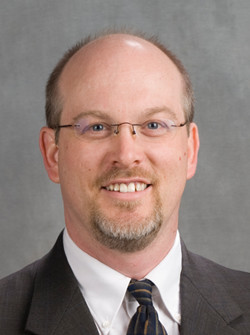Brad Andersh

Director of Sponsored Programs and Professor, Mund Lagowski Department of Chemistry and Biochemistry
Bradley Hall 17
(309) 677-3493
bja@bradley.edu
Ph.D., Organic Chemistry, Iowa State University
B.S., Chemistry, University of South Dakota
Biography
Dr. Andersh joined the faculty at Bradley University in 1993 after completing his Ph.D. under the direction of Dr. George Kraus at Iowa State University. As an undergraduate he did research with Dr. Miles Koppang at the University of South Dakota and with Dr. Thomas Engler at the University of Kansas (NSF-REU).
Teaching
Dr. Andersh, who was the 2013 recipient of the Putnam Award for Excellence in Teaching at Bradley University, has taught a wide variety of courses during his career but most recently he has taught: Organic Chemistry I, Organic Spectroscopy, Advanced Organic Chemistry, General Chemistry I, and Fundamentals of General Chemistry.
Scholarship
Since joining the faculty at Bradley, over 55 students (high school, undergraduate, and graduate) have worked with Dr. Andersh on various research projects. The primary theme of this work has been on the development of new synthetic methods and the utilization of these methods for the preparation of biologically active compounds (ex. pharmaceuticals).
His research group is currently working on an environmentally friendly method for performing selective alkylations of 1,3-dicarbonly compounds. Because the acidities of the protons of 1,3-dicarbonyl compounds are different, beta-ketoesters and other 1,3-dicarbonyl compounds can be alkylated selectively in either the 2- (alpha) or the 4-(gamma) position. Gamma-carbon-alkylation of a 1,3-dicarbonyl compound is most commonly accomplished by trapping a preformed dianion of the 1,3-compound with an electrophile. Traditionally, highly reactive bases such as lithium diisopropyl amide, sodium hydride, and n-butyl lithium have been used for this transformation. They have found that equilibrating bases such as carbonates and alkoxides can be used in place of these strong bases for gamma-C-alkylation of 1,3-dicarbonyl compounds. This discovery contradicts the current mechanistic generalization that a strong base is necessary for this chemistry.
Dr. Andersh’s research group is also working on the synthesis and testing of antimicrobial agents. Additional antibiotics must be continually developed to combat antibiotic resistance, which is a normal evolutionary response to the stress that exposure to antibiotics places on bacteria. Although considerable media attention has recently been given to this growing problem, antibiotic resistance was first observed in the 1940s. Efforts to develop new antibiotics commonly revolve around two approaches: the structural modification of existing antibiotics or the discovery of new classes of antibiotics. The focus of our research is a combination of these two approaches. They have discovered that highly substituted pyranones have antibiotic activity, and they have been able to increase the activity of these compounds by making structural changes.
Recent Publications and Presentations
- “Investigation of The Mechanism for the Preparation of 6-Phenyldihydro-2H-pyran-2,4(3H)-diones by the Potassium Carbonate Promoted Condensation between Acetoacetate Esters and Benzaldehyde.” Brad Andersh, Elizabeth T. Nguyen, Ryan J. Van Hoveln, Dylan K. Kemmerer, David A. Baudo, Jessica A. Graves, Mollie E. Roark, and Wayne B. Bosma, The Journal of Organic Chemistry 2013,
- “Synthesis of Chloro Alkoxy and Alkoxy Derivatives of Methyl Oleate.” Benjamin A. Lowery, Brad Andersh, Terry A. Isbell, T. Journal of the American Oil Chemists’ Society, 2013, 90, 911-917. 78(9), 4563-4567.
- “6-Phenyloxane-2,4-dione.” Kara A. Slater, Brad Andersh, Edward B. Flint, Greg M. Ferrence, Acta Crystallographica Section E Structure Reports Online 2013, 69, o69.
- “Addition of “HOBr” to trans-Anethole: Investigation of the Regioselectivity and the Stereoselectivity of an Addition Reaction.” Brad Andersh, Wayne B. Bosma, Margaret K. Hammar, Jessica A. Graves, Kathryn N. Moon, and Chareese R. Newborn, Journal of Chemical Education, 2013, 90 (11), 1504–1508.
- “Gamma-Carbon-Alkylation of b-Dicarbonyl Compounds Using Equilibrating Conditions” Brad Andersh, Kelsey Smith, Joshua Hinman, Christy Joseph, and April Balagna: American Chemical Society National Meeting, Indianapolis, IN, September, 2013.
- “DFT calculations of pKa values in methanol in different continuum solvation models: Avoiding empirical corrections” Wayne B Bosma, Gary Bondarevsky, Joshua Hinman, and Brad Andersh; American Chemical Society National Meeting, Indianapolis, IN, September, 2013.
- “Effects of Acids on Reduction of Benzylic Alcohols and Benzaldehydes Using Palladium Colloids Encapsulated in Polydimethylsiloxane.” Giuliana Bailey, John. Ziegenhorn, Michelle Baliss, Jordan Hinman, Dean Campbell, Richard Villarreal, Brad Andersh; American Chemical Society National Meeting, Indianapolis, IN, September, 2013.
- “Influence of Substituents on the Antibiotic Activity of Highly Substituted δ-Lactones,” Katie Fox, Kyle Morgenstern, Lee Raube, and Brad Andersh; American Chemical Society National Meeting, New Orleans, April 2013.
- Synthesis of palladium colloids within polydimethylsiloxane and their use as catalysts for hydrogenation” Dean J. Campbell, Josiah D. Miller, Brad J. Andersh, Journal of Colloid and Interface Science, 2011, 360, 309-312.
Service
Dr. Andersh served as department’s representative on the University Senate for 15 years. Currently he is chair of the Department, and he is serving on the University’s Contractual Arrangement Committee.

